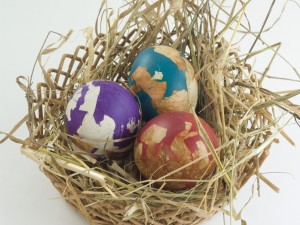We’ll take any opportunity to share a bit of Swedish culture with you!
Today we’d like to explain a few Swedish Easter traditions:
The Swedish word for Easter is påsk, which comes from the Greek word “paska” and the Hebrew word “pesach”, referring back to the Passover (when the Israelites exited Egypt).
In the 17th century the old custom of “paskriket” began when family members gave each other a birching. Typically the fathers whipped their family with a bunch of twigs on the morning of either Fat Tuesday or Good Friday, to remind their children of Jesus’ suffering. Later on, the tradition became more of a game, with children “whipping” their parents in the morning. By the 1930s it had become common to add colorful feathers to the twigs.
In Sweden, yellow is the predominant color for Easter because of its association with important symbols like feathers, daffodils, and chickens. The liturgical colors are black, white, and violet.
The main Easter symbol is the egg (påskägget), made of paper or plastic and covered with pictures of chickens. These eggs are filled with candy and given to children. The symbolism is of death and resurrection; the egg represents a grave and the hatching chicken represents new life. There is no Easter Bunny in Sweden.
The “påskkärring” is an old tradition with roots in Maundy Thursday. According to legend, when Judas Iscariot betrayed Jesus, all the world’s evil spirits were let loose. By the 17th century, women were being executed if it was thought that they were participating in the “banquet of the devil”. This activity all took place on the island of Blåkulla, where witches supposedly flew on broomsticks. The Swedish children dressed up like påskkärringar by donning Grandma’s dress, apron, and a kerchief tied under the chin, painting rosy cheeks and freckles on their faces. They then picked up a broom, an old-fashioned coffee pot, and a basket and walked around the neighborhood as if it were Halloween, giving out drawings to all those who gave them candy.
The entire week leading up to Easter has significance in Sweden, starting on Palm Sunday (Palmsöndag), when pussy willows are sometimes used in place of palms. Black Monday (Svarta måndag) was the day when chimneys were swept in the old days. White Tuesday (Vita tisdag) reflects the nice, clean chimneys. On Wednesdays (Dymmelonsdag) everyone was encouraged to be quiet, and even church bells were silenced. For some people, this was their last day of work for the week. Maundy Thursday (Skärtorsdag), the day of the Last Supper, was considered a dangerous day, as evil spirits were abroad and the devil tried to get you to sign a contract for your soul. Good Friday (Långfredag), the day Jesus was crucified, was a long and painful day during which many people traditionally fasted. Until recently, public entertainment was prohibited on this day. Saturday (Påskafton) is more characteristic of Christmas Eve, a day for feasting and eating and Easter fires (påskeldar). Easter Day (Påskdagen), the day Christ was resurrected, often started with people watching the sun “dance” in the morning, followed by chiming bells and organs playing.
Though Swedish Easter meals vary by region, popular dishes include eggs, lamb, and salmon. The food is light and usually includes marzipan and candy-filled Easter eggs for dessert. The “påskbord” (Easter smorgasbord) includes eggs, pickled herrings, salmon and Jansson’s temptation.
Sources: Easter in Swedish? and Happy Easter!


